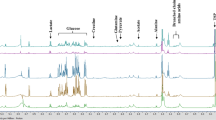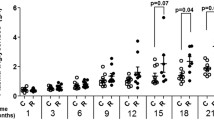Abstract
Arsenic is a widespread natural metalloid element. Long-term chronic exposure to arsenic can lead to different degrees of liver injury. Although the etiology of this disease is well known, to date, the underlying mechanism of arsenic-induced liver injury remains unclear, and no specific treatment exists because of the complexity of arsenic. In the present study, potential biomarkers and metabolic pathways in the livers of Wistar rats treated with arsenic for 24 weeks were investigated using an integrated metabolic approach with an LC-Orbitrap Q Exactive™ HF-X mass spectrometer. Markedly increased liver levels of arsenic, alanine aminotransferase (ALT), alkaline phosphatase (ALP), and total bile acid (TBA) were detected in the arsenic treatment groups (P < 0.05). Furthermore, histopathological examination of liver tissues showed obviously swollen, loose cytoplasm and increased necrosis in the arsenic treatment groups compared with those in the control group (P < 0.05). Metabonomics results showed that 109 metabolites (variable importance in the projection (VIP) > 1; fold change > 2 or < 0.5; P adjusted < 0.05) changed significantly after exposure to arsenic and included 71 upregulated metabolites and 38 downregulated metabolites. Additionally, Kyoto Encyclopedia of Genes and Genomes (KEGG) pathway analysis showed that 6 metabolic pathways with statistical significance—phenylalanine metabolism, pyruvate metabolism, glycolysis/gluconeogenesis, citrate cycle (TCA cycle), thiamine metabolism, and vitamin B6 metabolism—were selected, and 13 differential metabolites were detected to be involved in regulating these metabolic pathways. The present study could help identify potential biomarkers and their functions, as well as metabolic pathways, likely providing evidence for the early diagnosis, prevention, and mechanistic study of arsenism.








We’re sorry, something doesn't seem to be working properly.
Please try refreshing the page. If that doesn't work, please contact support so we can address the problem.
Similar content being viewed by others
Data Availability
The datasets generated during and/or processed during the current study cannot be shared at this time as the data forms part of an ongoing study but are available from the corresponding author on reasonable request.
References
Cancer I (1987) Overall evaluations of carcinogenicity: an updating of IARC Monographs volumes 1 to 42. IARC Monogr Eval Carcinog Risks Hum Suppl 7:1–440
Levine B, Kroemer G (2019) Biological functions of autophagy genes: a disease perspective. Cell 176:11–42
Hu Y, Xiao TT, Zhang AH (2021) Associations between and risks of trace elements related to skin and liver damage induced by arsenic from coal burning. Ecotox Environ Safe 208:111719
Lv Y, Hu Q, Shi MY et al (2020) The role of PSMB5 in sodium arsenite–induced oxidative stress in L-02 cells. Cell Stress Chaperon 25:533–540
Das N, Paul S, Chatterjee D et al (2012) Arsenic exposure through drinking water increases the risk of liver and cardiovascular diseases in the population of West Bengal. India BMC Public Health 12:639
Ma J, Yu J, Su X et al (2014) UPLC-MS-based serum metabonomics for identifying acute liver injury biomarkers in Chinese miniature pigs. Toxicol Lett 225:358–366
Wu X, Huang Y, Sun J et al (2018) A HILIC-UHPLC-MS/MS untargeted urinary metabonomics combined with quantitative analysis of five polar biomarkers on osteoporosis rats after oral administration of Gushudan. J Chromatogr B Analyt Technol Biomed Life Sci 1072:40–49
Yuan TF, Le J, Cui Y et al (2019) An LC-MS/MS analysis for seven sex hormones in serum. J Pharm Biomed Anal 162:34–40
Sun RL, Zhang J, Xiong MZ et al (2012) Metabonomics biomarkers for subacute toxicity screening for benzene exposure in mice. J Toxicol Environ Health 75(18):1163–1173
Saha N, Rahman MS (2020) Groundwater hydrogeochemistry and probabilistic health risk assessment through exposure to arsenic-contaminated groundwater of Meghna floodplain, central-east Bangladesh. Ecotoxicol Environ Saf 206:111349
GB (National Standard of P.R.China) (2010) 14924.3–2010, Laboratory animals-Nutrients for formula feeds [S]
Shi MY, Hu Q, Bi DN et al (2021) Dicer1, miR-155 regulate the gene expression of SOD1 in sodium arsenite induced liver injury in rats[J]. J Environ Occup Med 38(5):492–498
Hu Y, Li J, Lou B, et al (2020) The role of reactive oxygen species in arsenic toxicity. Biomolecules 10 (2):240
Hu Y, Yu C, Yao ML et al (2018) The PKCδ-Nrf2-ARE signalling pathway may be involved in oxidative stress in arsenic-induced liver damage in rats. Environ Toxicol Phar 62:79–87
Islam K, Haque A, Karim R et al (2011) Dose-response relationship between arsenic exposure and the serum enzymes for liver function tests in the individuals exposed to arsenic: a cross sectional study in Bangladesh. Environ Health 10:64
Hye MA (2018) Arsenicos is: a review of its diagnosis and treatment. Medicine 30(2):81–88
Olsvik PA, Skjaerven KH, Softeland L (2017) MMetabolic signatures of bisphenol A and genistein in Atlantic salmon liver cells. Chemosphere 189:730–743
Mohib MM, Afnan K, Paran TZ et al (2018) Beneficial role of citrus fruit polyphenols against hepatic dysfunctions: a review[J]. J Diet Suppl 15(2):223–250
García-Sevillano MA, Contreras-Acuña M, García-Barrera T et al (2014) Metabolomic study in plasma, liver and kidney of mice exposed to inorganic arsenic based on mass spectrometry[J]. Anal Bioanal Chem 406(5):1455–1469
Flaherty DC, Hoxha B, Sun J et al (2010) Pyruvate-fortified fluid resuscitation improves hemodynamic stability while suppressing systemic inflammation and myocardial oxidative stress after hemorrhagic shock[J]. Narnia 175(3):166–172
Shi L, Tu BP (2015) Acetyl-coa and the regulation of metabolism: mechanisms and consequences [J]. Curr Opin Cell Biol 33:125–131
Martinez-reyes I, Diebold LP, Kong H et al (2016) TCA cycle and mitochondrial membrane potential are necessary for diverse biological functions[J]. Mol Cell 61(2):199–209
Funding
This work was funded by grants from the National Natural Science Foundation of China (grant no. 81860561, 81430077, U1812403, and 82160649).
Author information
Authors and Affiliations
Contributions
Hu Y and Zhang A contributed to the study’s conception and supervision. Bi D, Shi M, Hu Q, and Wang H performed the research. Lou D gave the assistance in consulting and collecting relevant data. All authors contributed to data analysis and interpretation and approved the final manuscript for submission.
Corresponding author
Ethics declarations
Ethics Approval and Consent to Participate
Not applicable.
Consent to Publish
Not applicable.
Competing Interests
The authors declare no competing interests.
Research Involving Human Participants and/or Animals
All procedures performed in studies involving animals were in accordance with the Guide for the Care and Use of Laboratory Animals (National Research Council, 1996). And the study was approved by the Animal Care Welfare Committee of Guizhou Medical University.
Informed Consent
Not applicable.
Additional information
Publisher's Note
Springer Nature remains neutral with regard to jurisdictional claims in published maps and institutional affiliations.
Rights and permissions
About this article
Cite this article
Bi, D., Shi, M., Hu, Q. et al. LC/MS/MS-Based Liver Metabolomics to Identify Chronic Liver Injury Biomarkers Following Exposure to Arsenic in Rats. Biol Trace Elem Res 200, 4355–4369 (2022). https://doi.org/10.1007/s12011-021-03026-0
Received:
Accepted:
Published:
Issue Date:
DOI: https://doi.org/10.1007/s12011-021-03026-0




